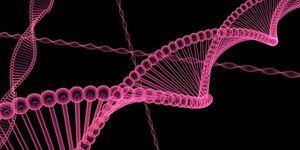New Insight Into the Regulation of Sleep
Once thought of as supporting structures, researchers are uncovering more roles for astrocytes, a type of cell in the brain with a shape like a star. Researchers at the Washington State University Sleep and Performance Research Center have now confirmed that they play a critical role in sleep. Astrocytes in fruit fly brains were found to signal to neurons, regulating sleep time. The findings, reported in PLOS Genetics, are thought to also apply to humans and may help researchers understand the importance of sleep.
"We spend about a third of our lives asleep, and yet we don't really know why," said the first author of the report, William Vanderheyden, an assistant research professor in the Elson S. Floyd College of Medicine. "Our work uses the fruit fly as a tool to identify mechanisms of sleep regulation that might be conserved across species -- from fruit flies all the way to humans -- so we might someday understand the function and process of sleep and could develop therapies to alleviate the burden of sleep loss."
Fruit flies have long been used as a genetic model. The scientists used them to follow up on recent findings on an inflammatory molecule called TNF-alpha - it plays an essential part in the regulation of sleep.
"Fruit flies happen to have a molecule that is very similar to TNF-alpha that is called Eiger, and the receptor to which it binds is called Wengen," Vanderheyden said. "What we tried to identify through this research were mechanisms by which Eiger and Wengen could be regulating sleep in the fruit fly."
The researchers bred flies that lacked a gene that controls Eiger, and the flies slept less. When they did sleep, it was more fragmented. Next, flies that lacked Eiger only in certain brain cells were generated. When Eiger was absent from astrocytes, the flies exhibited similar, fragmented, restless sleep patterns. But when the flies lacked Eiger in neurons, they slept normally.
Eiger thus seems to have a greater contribution to sleep time regulation, in an astrocyte-dependent manner, Vanderheyden said.
When the researchers exposed flies lacking Eiger and normal flies to human TNF-alpha protein, sleep levels increased, confirming mammalian results.
Lastly, they turned off the receptor for Eiger, called Weigen, in astrocytes or neurons in fruit flies. After depriving those flies of sleep for twelve hours, the researchers measured sleep levels, which normally would be exaggerated in a phenomenon called rebound sleep. When the Wengen receptor was turned off in astrocytes, rebound sleep levels were unchanged. But, if the receptor was inactivated in neurons, sleep rebound was significantly reduced. TNF-alpha did not affect flies carrying neurons with inactivated Wengen receptors.
"This suggests that this signal from Eiger is going from astrocytes to neurons to drive sleep, which is a new finding," said the study’s senior author Jason Gerstner, assistant research professor in the Elson S. Floyd College of Medicine. "This generates a new hypothesis about the way we think sleep may be regulated in higher-order animals, including humans."
Vanderheyden and Gerstner are planning to investigate this process in mammals next and will use rodents to study this astrocyte-to-neuron sleep pathway. They are following up on the pathway in a fruit fly model of Alzheimer's disease. In that model, sleep loss, as well as astrogliosis occurs, in which astrocyte numbers increase as nearby neurons are destroyed.
Sources: AAAS/Eurekalert! via Washington State University, PLOS Genetics










